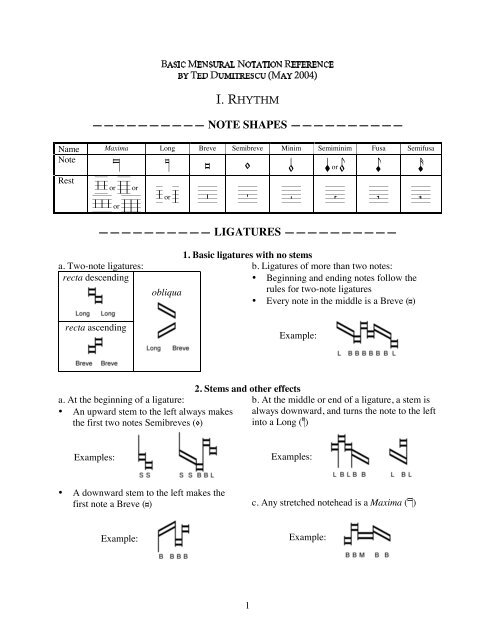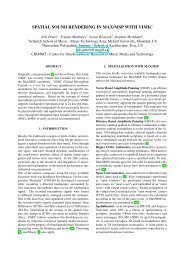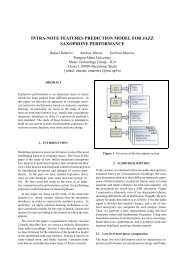Basic Mensural Notation Reference
Basic Mensural Notation Reference
Basic Mensural Notation Reference
Create successful ePaper yourself
Turn your PDF publications into a flip-book with our unique Google optimized e-Paper software.
% 0 1 5<br />
7 ' 0<br />
, 5+
———— STANDARD MENSURATIONS AND PROPORTIONS ————<br />
1. Mensuration<br />
• 2 and & are the signs of perfect and imperfect tempus: i.e., whether a Breve (F) contains 3 or<br />
2 Semibreves (G) by default<br />
• Presence or absence of a dot (•) in the center of the tempus sign indicates major or minor<br />
prolation: i.e., whether a Semibreve (G) contains 3 or 2 Minims (H) by default<br />
& (imperfect tempus, minor prolation):<br />
* (imperfect tempus, major prolation):<br />
2 (perfect tempus, minor prolation):<br />
4 (perfect tempus, major prolation):<br />
2<br />
F = G G = H H H H<br />
F = G G = H H H H H H<br />
F = G G G = H H H H H H<br />
F = G G G = H H H H H H H H H<br />
• Major modus refers to the number of Longs (E) in a Maxima (D) (perfect is 3, imperfect is 2)<br />
• Minor modus refers to the number of Breves (F) in a Long (E) (perfect is 3, imperfect is 2)<br />
• Modus is detected most easily by observing how many Long rests are in a Maxima rest, and<br />
how many Breve rests are in a Long rest:<br />
Imperfect major modus,<br />
Imperfect minor modus<br />
Imperfect major modus,<br />
Perfect minor modus<br />
Perfect major modus,<br />
Imperfect minor modus<br />
Perfect major modus,<br />
Perfect minor modus<br />
——————— IMPERFECTION AND ALTERATION ———————<br />
1. Imperfection: Taking away 1/3 of the length of a ternary note<br />
From the back (“a parte post”):<br />
2 F F G F = _ _ __<br />
* G H G F = _ __<br />
By smaller values:<br />
2 F H H F = _ __<br />
* I I G H H H F = _ __<br />
“Like before like” (“similis ante similem”) is<br />
never imperfected:<br />
* H G G H H H G F = _ _ __<br />
Never by a ternary group:<br />
2 F G G G F = _ _ __<br />
* G H H H G G F = _ _ __<br />
3<br />
From the front (“a parte ante”):<br />
2 G F G H H G F = _ _ __<br />
* H H H H G F = _ __<br />
From both sides:<br />
2 H F H F F = # _ _ __<br />
By “remote parts” (“a partibus remotis”):<br />
* F H G G F = # _ _ __<br />
4 G H F H F = # _ __<br />
Rests are never imperfected (but they can<br />
imperfect notes):<br />
2 N L F G G G F = _ _ _ __<br />
2. Alteration: Doubling a note value to complete a ternary grouping<br />
2 G G F = _ __<br />
* H H G F = _ __<br />
Always the last possible note:<br />
2 G G G G G F = _ _ __<br />
Between two perfect notes, always occurs:<br />
2 F G G F = _ _ __<br />
* G I I H G G F = _ _ __<br />
Rests are never altered:<br />
2 L L F G F = #_ _ __
—————————— DOTS ——————————<br />
1. Dot of Addition (“punctus augmentationis/additionis”)<br />
• Increases the length of a note by half (like the modern dot)<br />
• Can only be applied to binary note values (e.g., a Semibreve under 2)<br />
2 G G H F = _ __<br />
2. Dots of Division/Perfection/Alteration/etc.<br />
• Act as measure dividers for ternary values (e.g., a Semibreve under *)<br />
• In order to separate ternary groups, can force imperfection and alteration or prevent them<br />
2 F G G F = _ __ * G H H H G G F = _ _ __<br />
• The rare punctus reductionis or syncopationis (dot of syncopation) can appear in the middle<br />
of a ternary group; by preventing alteration or imperfection it causes syncopation<br />
* H H G H H F = _ __<br />
—————————— COLORATION ——————————<br />
1. Imperfection coloration<br />
• At ternary mensural levels, colored notes are always imperfect and cannot be doubled<br />
through alteration<br />
• Colored notes are often found in groups adding up to pairs of ternary measures<br />
• Dots in coloration groups are dots of addition (affecting the imperfect, unaltered values)<br />
2 F Q Q Q F = _ #_ _ __ 2 R Q R I F = #_ _ __<br />
• Such groups fall at measure beginnings, causing alteration if necessary<br />
2 G G P Q F = _ #_ _ __<br />
2. Proportional coloration<br />
• For binary note values, coloration takes away 1/3 of the value (creating modern triplets)<br />
• The rules for imperfection coloration still apply (all notes imperfect, no alteration)<br />
3 3<br />
& G G R R R F = _ _ __ & G H H I I I G F = _ _ __<br />
• Some special cases (later 15th and 16th centuries):<br />
& 2 R I = H I ' Q R = G H ' Q I I = G I I<br />
4
,, 3,7&+<br />
Gamut Hexachords Note names Principal clefs<br />
ee<br />
dd<br />
cc<br />
aa<br />
g<br />
f<br />
e<br />
d<br />
c<br />
a<br />
G<br />
F<br />
E<br />
D<br />
C<br />
A<br />
+<br />
la<br />
sol<br />
fa<br />
mi<br />
re<br />
ut<br />
la<br />
sol<br />
fa<br />
mi<br />
re<br />
ut<br />
la<br />
sol<br />
fa<br />
mi<br />
re<br />
ut<br />
la<br />
sol<br />
fa<br />
mi<br />
re<br />
ut<br />
la<br />
sol<br />
fa<br />
mi<br />
re<br />
ut<br />
la<br />
sol<br />
fa<br />
mi<br />
re<br />
ut<br />
la<br />
sol<br />
fa<br />
mi<br />
re<br />
ut<br />
5<br />
ee la<br />
dd la sol<br />
cc sol fa<br />
fa mi<br />
aa la mi re<br />
g sol re ut ———<br />
f fa ut<br />
e la mi<br />
d la sol re<br />
c sol fa ut ————<br />
fa mi<br />
a la mi re<br />
G sol re ut<br />
F fa ut —————<br />
E la mi<br />
D sol re<br />
C fa ut<br />
mi<br />
A re<br />
+ ut ——————<br />
• In any hexachord, the step mi – fa is a semitone; every other step is a whole tone<br />
• The sign (“round b”) marks a note as fa, which means it is only a semitone above the step<br />
below it; usually this means the marked note must be flattened by a semitone<br />
• The sign (“square b”) marks a note as mi, which means it is a semitone below the step<br />
above it; this usually causes the marked note to be sharpened by a semitone, cancelling the<br />
effect of if necessary<br />
:<br />
:<br />
• The sign (“dyesis”) simply causes a note to be sharpened by a semitone, without<br />
necessarily changing the hexachord syllable; it is often used loosely, however, with the same<br />
meaning as<br />
:<br />
+
————————— DIRECTED PROGRESSIONS —————————<br />
• In counterpoint, when an imperfect consonance (3rd, 6th) moves to a perfect consonance<br />
(unison, 5th, octave), the imperfect consonance should be performed as major or minor in<br />
order to approach the perfect consonance with the smallest movement (e.g., a 6th expanding<br />
to an octave should be major, a 3rd contracting to a unison should be minor)<br />
• Sharps and flats can be performed to ensure this type of “closest approach”<br />
6 - 8<br />
;<br />
3 - 1<br />
;<br />
or<br />
3 - 5<br />
————————— MELODIC LEADING TONES —————————<br />
• The “returning note” melodic phrases re ut re, sol fa sol, and la sol la should be performed<br />
with a sharp leading tone (raising the lower neighbor note by a semitone)<br />
• Such melodic phrases often appear in ornamented forms, which require the same sharpening<br />
;<br />
;<br />
;<br />
;<br />
6<br />
6 - 8<br />
;<br />
;<br />
3 - 5<br />
;<br />
;
—————— PERFECT INTERVALS IN COUNTERPOINT ——————<br />
• In counterpoint, “false consonances” (augmented and diminished perfect consonances)<br />
between two voices are to be avoided: augmented and diminished 5ths, octaves, unisons<br />
• If the default reading produces a false consonance, one voice should lower its pitch by a<br />
semitone and call that note fa, which will produce a perfect consonance<br />
:<br />
:<br />
———————— PERFECT MELODIC INTERVALS ————————<br />
1. Melodic phrases<br />
• If a melodic phrase outlines a tritone (an augmented 4th, e.g., F fa - mi), the higher note<br />
should be lowered by a semitone and called fa, to make a perfect 4th<br />
;<br />
• If the phrase continues by step in the same direction to complete a melodic 5th, no flattening<br />
is necessary<br />
;<br />
:<br />
2. Leaps<br />
• Leaps of a 4th, 5th, and octave should be rendered as perfect intervals, using flattening (with<br />
the syllable fa) if necessary<br />
;<br />
;<br />
7<br />
:<br />
;<br />
;









